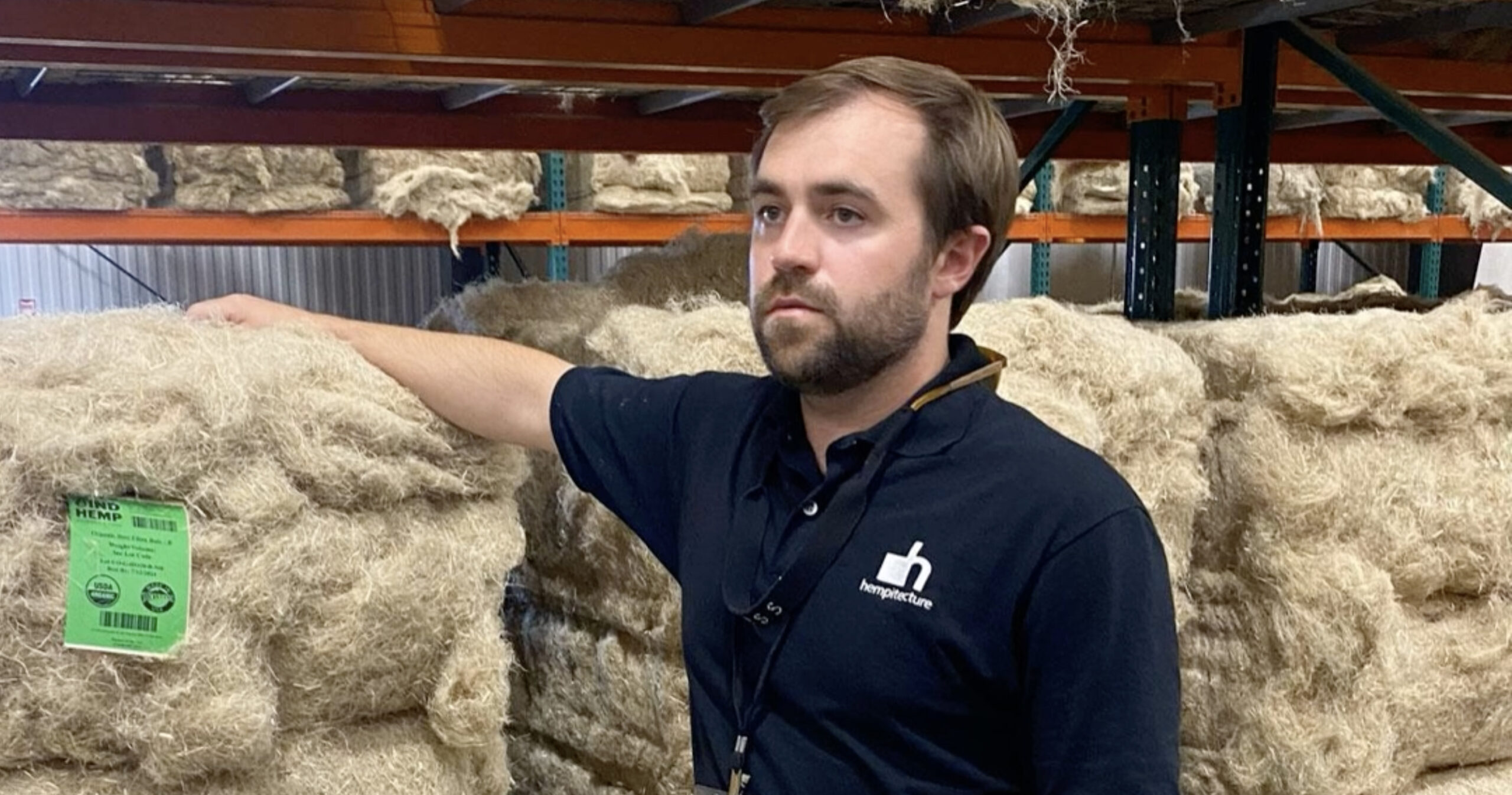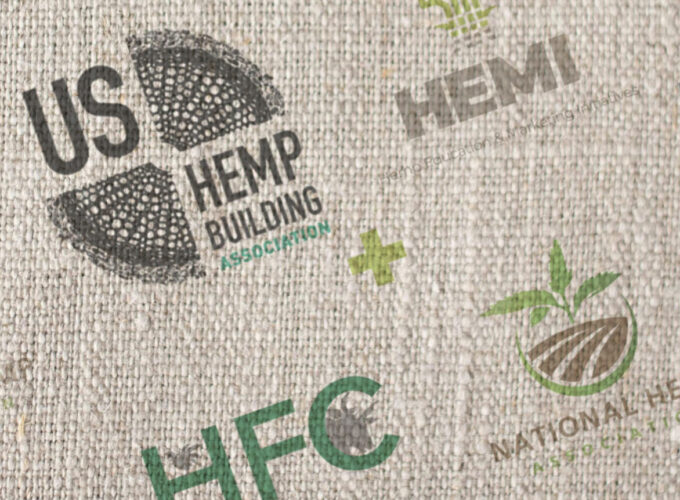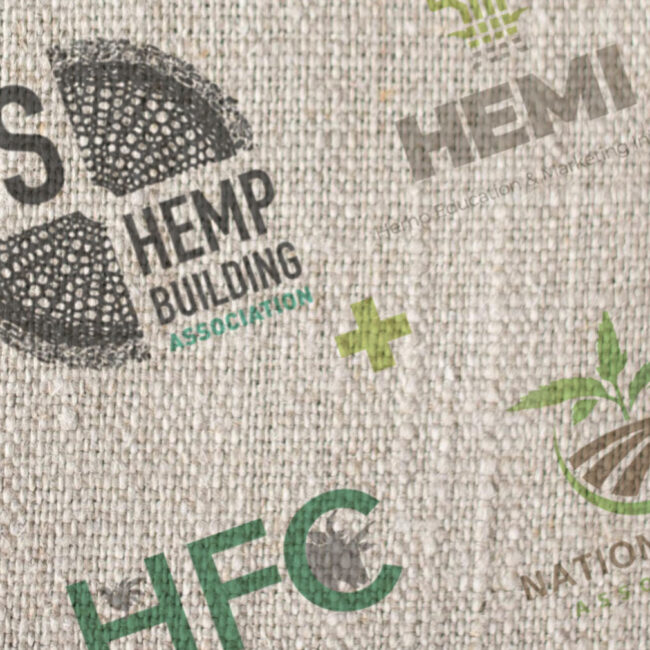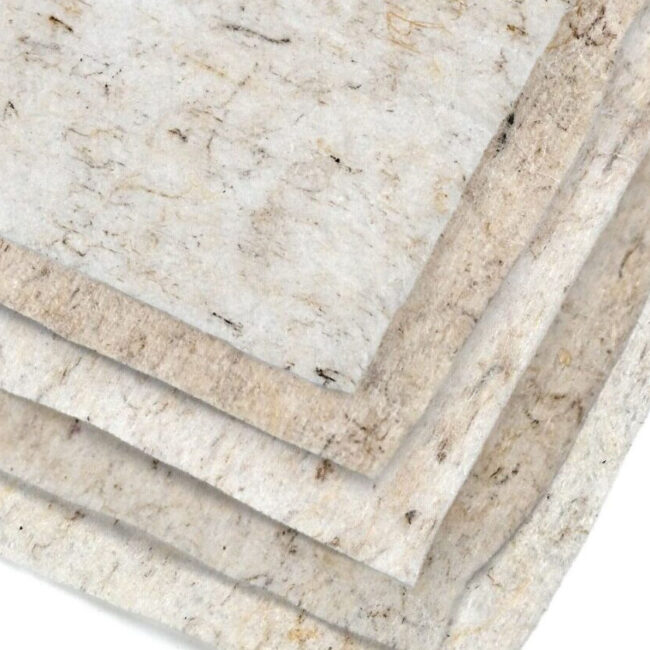Listen to Podcast via YouTube, Click Here.
“Our vision is to help reduce the environmental burden of a lot of other industries namely the built environment and solve a really big problem and that problem is that within our built environment 40% of our domestic carbon emissions come from our buildings. So if we were only building 1, 2, or 3 hemplime or hempcrete homes a year—are we meeting that vision? So this transition—this pivot towards nonwovens—was a way to really proliferate the goodness of hemp.”
That’s Mattie Mead from Hempitecture. This is the Lancaster Farming Industrial Hemp podcast. Hello, my name is Eric Harlock here with Sophia Kurszius. Today we’re diving into the world of nonwovens: what are they, how are they made, what’s the opportunity for the hemp industry here? And what’s the hemp opportunity for the nonwoven industry? We’re going to find out today here on the Hemp Show.
How you doing, Sophia?
I’m doing good. How are you, Eric?
I’m doing all right. So, you’ve been in this hemp space with me for a little while now and maybe you’ve heard this phrase that hemp has over 25,000 uses?
25,000—yeah.
That’s a lot, right? It’s like overwhelming—like when you’re scrolling through Netflix trying to pick a movie and just like ah..hmmmm. So what do you do with 25,000 uses? You pick one.
And so of all the 25,000 uses you’ve chosen the nonwovens.
That’s right – we’re going to talk about nonwovens today. Apparently we are living in a world of nonwovens they are all around us.
And we don’t even know it.
Not yet. But today we’re going to look at this world of nonwovens: what they are, how they’re made, what they’re made from and—spoiler alert—most of them are not made from hemp. But they could be. That’s what we’re going to find out here today. We’re going to talk to Mattie Mead who knows a thing or two about the nonwoven sector, especially focused on carbon negative bio-based materials for construction.
……..
Mattie Mead – welcome back to the show. How are you doing?
Eric always great to be here with you my friend
Could you give us a quick introduction?
Yeah. My name is Mattie Mead, I’m the founder and CEO of Hempitecture. And Eric, you hit the nail on the head: we manufacture bio-based, carbon-negative, high-performing materials using primarily industrial hemp fiber. You also mentioned we focus really on the built environment so our products span thermal insulation, in bat format, board format—but we’re also really starting to play in some new and exciting places in the nonwoven world. It’s amazing to me how ubiquitous nonwovens are in our world.
I had no idea that they even existed. But as I’ve been researching the show I really do see that nonwovens are everywhere. They’re in medical masks, diapers, car interiors, insulation air filters even reusable shopping bags so where do we even start?
Well, hopefully we can start at the beginning. Mattie how do you explain to people what a nonwoven is?
First, I have a question for you Eric did you sleep on a mattress last night?
Yeah, part of the time—it’s a long, long story…but yeah.
Okay if you slept on a mattress last night you interacted with nonwovens. Are you sitting on a chair right now?
I am on a chair. How did you know that? Can you see us?
Does the chair have anything soft in it?
Why it does—it’s got like a cushion on it.
The cushion that you’re sitting on—that’s a nonwoven, Eric. You’re in your home office right now—so I think the answer to this question might be no—but did you drive to work today or did you drive a car today?
I have not driven a car in a few weeks but again that’s a whole different story.
Well, bless you for your carbon footprint because you are doing our planet a service—but if some of the other listeners today, maybe they’re in their car right now listening to the Lancaster Farming Industrial Hemp podcast on their way to or from work or wherever they may be. If they’re in a car right now they’re interacting with nonwovens. The car door panels are made of layers of nonwovens. Your trunk liner—if you peel up the finished carpet—you’re probably gonna find a nonwoven in there. If you rip apart your dashboard—which I don’t recommend you do cause usually it’s a lot easier to rip it apart than to put it back together—you’re going to find layers of nonwovens. So nonwovens are a huge part of our world. They’re quite literally everywhere
I’m guessing there’s more nuance to nonwovens are there more than one kind?
There’s durables and non-durables. So everything that I mentioned like a mattress or a cushion or car materials those are considered durable nonwovens. They’re long-lasting. Then there’s the world of non-durables: those are things more like wipes and hygiene products.
Okay. But they’re all sort of made the same way?
It is taking fibers together and conglomerating them into a useful form that has a long life. The design of that fibrous matrix, the design of the material formulation, it’s all going to be based off the application and use case for the product.
Spoken like an architect, thank you for that. I’m a bit of a simpleton myself and when I think of nonwovens I think of them as the opposite of woven, right? Like textiles are woven and the fibers are organized into a pattern to maximize strength. I don’t know—I’m sort of winging this. But nonwovens then are the opposite of that, and the fibers aren’t really organized but are kind of like molded together in chaos kind of makes me think of felting?
Absolutely. And it sounds almost like it would be “huh…nonwovens?” It really in a way is the inverse of a woven. If you’re wearing textiles right now or clothing it’s all fibers that are woven together. The mechanical means of uh bringing these fibers together is weaving.
In a nonwoven the mechanical means of bringing them together is not through weaving it’s through other pathways that conglomerate the fibers into a useful form.
Okay I think I’m starting to get the lay of the land here: nonwovens are everywhere and hempitecture focuses on what you call the built environment…
If you peeled off the drywall in your home there’s a good chance that the insulation in your wall is fiberglass if it’s a fiberglass material well that is certainly a nonwoven.
Okay so if nonwovens are everywhere and are in use by many different industries: construction, consumer goods, automotive, healthcare, packaging, filtration, agriculture, on and on and on—it must be a very valuable industry?
Yeah. According to Allied Market Research the global nonwoven fabric market is valued between $58 billion – $62 billion with projections indicating growth to $104 billion by 2033.
Okay then, but obviously that’s not all hemp?
No not all hemp. Hemp is just one little tiny part of it it’s one of several natural fibers which altogether only make up less than 15% of that global market. It’s small but it’s growing.
Let me guess the remaining 85% of nonwovens are made from plastic?
Bingo.
Often times polypropylene, polyester, polyethylene—all the polys. And when you realize how much nonwovens are a factor in our daily lives. Think about if 1% of that were natural fiber—or 5% or 10%—what the benefit to people and planet could be, and that is a vision that really drives Hempitecture forward.
Let’s talk about Hempitecture. You started out in Hemprete, but then you made a conscious decision to pivot to nonwovens?
100% Eric. When Hempitecture was founded—really as a dorm room idea when I was an architecture student—it was really focused on hemplime or hempcrete, bio-composites bringing together the inner wooden core of the hemp stock with a mineral-based binder. We’ve done everything from cast-in-place, pre-fabricated panels, spray-applied hempcrete—really run the gamut, as well as blocks: we’ve imported blocks from other countries. And we made that pivot—I would say not necessarily away from hemprete—but towards an additional opportunity which was nonwovens in around 2020.
We saw that nonwovens play such a massive part in our world today and we could bring industrial hemp fiber—which just offers so many benefits both in terms of the finished product and backwards down the value chain all the way to the farm level which from our point of view is super important—that ultimately allowed for increased scale. Our vision is to help reduce the environmental burden of a lot of other industries namely the built environment and solve a really big problem and that problem is that within our built environment 40% of our domestic carbon emissions come from our buildings. So if we were only building 1, 2, or 3 hemplime or hempcrete homes a year—are we meeting that vision? So this transition—this pivot towards nonwovens—was a way to really proliferate the goodness of hemp—to borrow a term from our friends over at IND Hemp.
Don’t get me wrong: hemplime is a fantastic building material. I think it remains to be one of the opportunities of our time and there’s so much potential there. The development cycle that I’ve seen in Hemprete since first becoming interested in it in 2012 is just phenomenal. The scale in which we’ve reached…was hard to imagine in 2013, with now hundreds of homes being built with hemp lime or hemprete. But the challenge there, from our point of view, is it does really require a lot of specialty craft specialty knowledge and that can be hard to overcome. In our very conventional world of building in the United States we’ve been building homes more or less the same way since the post World War II boom. We’re stick framing homes, we’re putting insulation in-between our framing members, our studs. So if we could come up with a product that is utilizing natural fibers that are now more newly available like industrial hemp fiber and put it in a format that fits inside the prescriptive formula that we have for building homes instead of serving 2, 3, 4, 5 homes a year we can serve 300, 400, 500 homes a year if not more. That’s a big difference.
Can you walk us through the process a bit? You mentioned IND Hemp who I think provides some or most of your raw material. What happens after the hemp is delivered to your plant at Hempitecture?
We like to say that our building products start with a seed. And those seeds are planted by farmers. I think that is really, really important to understand that this is an agricultural resource and commodity that drives economic vitality on the rural level and there are very few other building materials that put dollars in farmers pockets. So we’re really proud of that, you know? We partner with a few companies—you mentioned IND Hemp. IND Hemp will contract acrage, the farmers will sow the seeds, they’ll raise that crop to maturity, they’ll cut it down in the field, then it’s bailed in the field. After it’s bailed in the field it is brought to their primary processing facility. That primary processing facility really does the leg work on separating out the valuable plant part constituents. we at Hempitecture buy bailed fiber.
How finely processed is that hemp fiber when you get it?
So, working closely with our partners we’ve defined a specification that is designed to really reduce the herd content which for fiber nonwovens we want as little of that as possible. It is geared towards fiber individualization, so separating out the fibers as much as possible.
Then what happens next?
We take that fiber we run it through a process you refining, opening, cleaning, dusting, and then we’re arrow entangling the fibers into a web. You have overlapping or crisscrossing fibers that are brought together through air suction and mechanical action. So, if you think of a spider’s web you’ll see you know like big gaps between kind of the threads or the fibers or the spider’s web. In our case we bring that gap size down to very small and we’re blowing a fibrous matrix of hemp fiber through this arrow entangling process. Now that’s just a critical step that then feeds down the line: we’re thermally bonding our materials and then ultimately at the end of the line it’s cut into different specifications in terms of length, width, the length of a roll. But when we think about the built environment and we go back to that idea of putting a fiber nonwoven into conventional construction all our products are cut to fit within that conventional system of building
Like 16 inch studs that kind of thing, correct?
16 inch on-center studs, 24 inch on-center, and we can also modulate the depth of our product. So, maybe in the Northeast you’re going to build with 2 x 6 studs for snow load over your roof and added insulation. We’ll produce a product that’s 5 1/2 inch. Or maybe you’re in a more temperate climate where you’re building with 2 x 4s—we produce products for those depths as well.
Can you give us a glimpse of tomorrow?
Absolutely so we’re really excited about what we’re developing right now which is unlike any other nonwoven process in the US or to the world as far as we know. We call this the fiber fortification process. Hemp fiber and other natural fibers—they already have great characteristics. So what are the ways that we can enhance those characteristics and add value to fibers that ultimately expand different end use applications? We’ve come up with a system with some partners overseas to help us add value to fiber, to further refine fiber, to further individualize fiber. I think this will ultimately be a game-changer for our product performance and the industries that we can serve. So we’re really really excited about this next chapter of increasing the already great potential of natural fibers like hemp.
Do you only use hemp or do you use other natural fibers as well?
We do. Of course our name is Hempitecture and hemp fiber is really the carbon capturing engine behind our product portfolio. Almost all of our products have some degree of industrial hemp especially our mainstay building products. Now we do toll manufacture for other companies
that might have a variety of product specifications. Maybe they use recycled textile fiber; maybe they use um cotton; maybe they use recycled resources; we will toll manufacture for these companies and really we view it as the start of a relationship when we start that relationship and we meet the specification of a toll manufacturer meaning company A says “Maddie I want you to produce a product at this weight at this depth with this fiber composition.” We say “Great let’s produce that.” And that opens the door to a conversation maybe they had never heard of industrial hemp fiber before or maybe they thought it was cost prohibitive once we develop a good rapport with these companies and we are producing their products on spec we can say “Hey have you thought about hemp fiber uh here’s the benefits to it here’s the cost tradeoff or um just you know the economic equation um here’s the value add to using hemp.”
Hemp is a gateway crop i hear…
for us it’s a way to open that door and start a meaningful conversation that we think will help drive growth and scale in the industrial hemp industry.
All right. Well let’s talk about products. I know you do an insulation, you do some sort of floor mats—you do all kinds of stuff. Let’s just run down the list what my options are…
When we set out to build our manufacturing plant we were really just focused on bat insulation. Bat insulation goes in between 2 x 4s and 2 x 6s—it’s your wall’s floor’s ceiling”’s our product Hemp Wool is a friction fit insulation that’s designed to stay tight and steady in your cavity that you’re insulating without slumping or sagging that was really our foray into the nonwoven world and and why we built our manufacturing plant but once we got our manufacturing plant set up it really became an exploratory sort of quest to find what are the high limits what are the low limits how can we push the technology that we have to create a wider range of products so that has led us into developing a highly compressive strength related board product this board product is used not so much as you know like a wood replacement but as a continuous insulation so it’s essentially an insulation board that’s rigid it’s cut to 2 ft x 4 ft that can be installed on the exterior of a wall system to eliminate thermal bridging creating highly energy efficient structures or can be used in other applications like underneath your drywall on the interior eric you’ll get a kick out of this this is pretty cool we even had someone recently try utilizing this new product our rigid board insulation called plant panel as a drywall replacement. they hung this plant panel this rigid board up on top of their studs and then they plastered the board directly so they completely eliminated drywall and while we did not start out saying “Hey this is a drywall replacement.” I think it just goes to show the potential of nonwovens made with hemp fiber to replace other conventionally used materials. So that was really, really cool. And our other core product today is a fiber pad which is a natural fiber carpet underlayment. If you have carpet under your feet right now and you peel up that carpet, there’s going to be a padding under there, guaranteed. That padding—that’s a nonwoven. Another place that nonwovens live. So we’ve developed a natural fiber, nonwoven, roll-good material (roll-good is kind of nonwoven nomenclature for material on a roll). So, we sell it in rolls and customers unroll it, they tack it down to their floor, and they can put their carpet or even hardwood floors over it. This is kind of just the tip of the iceberg but this is where we’re at today and we have a lot more coming in the future.
Very cool, and very exciting.
Okay so we’ve learned a lot about the nonwoven industry and the opportunity for hemp and biiobased fibers but let’s flip it around what should the nonwoven people know about the opportunity and the goodness of hemp?
Great question, Eric. What we’re doing in the United States is new but it’s not new internationally. There’s really great precedents overseas of companies that have been utilizing natural fibers like hemp fiber for a really long time, especially in that nonwoven format.
Let’s spin it back to the United States. We are the first hemp fiber insulation company in the United States, but hemp—while we have a great and rich agricultural heritage and history with it—in the United States, really kind of the original natural fiber is cotton. Cotton plays a massive role in so many industries from textiles and woven to nonwoven and disposables. I mean, cotton is everywhere. I think industrial hemp has a great role to play in meeting cotton, enhancing cotton, reducing the impact of cotton.
Our view of nonwoven manufacturing is that of an interdisciplinary school of thought. I think you’ll have other companies that are seeing what we’re doing—and the road has already been paved for them because we’ve done all the heavy lifting and hard work of commercializing a new product in the United States that no one has ever heard of before. Those companies are going to file in behind us and they’ve going to have an easier upshoot and onramp to market because we’ve done that heavy lifting. We’ve been at this, Eric, for over 2 years now. It’s really hard to see and understand what’s coming next and all the effort and energy that that goes in behind the scenes to capitalize on what we think is a great opportunity. And that opportunity—going back to that idea of interdisciplinary thinking—involves off-setting the use of other materials.
Like I said before, hemp is the carbon-capturing engine behind our product portfolio, but we can improve other products. We can bring hemp together with other natural fibers to proliferate A) the size of and scale of the industrial hemp industry, but B) proliferate more decarbonized sustainable materials. If you look at the segments that we are ultimately targeting that are not immediately available above-board when you go to our website and you say “Oh, Hempitecture is a building product manufacturer.” We’re looking at a $50 billion total addressable market. That comes across different industry verticals that transcend far beyond the built environment that all are nonwoven related. Now it doesn’t mean we’re going to make $50 billion next year—but the industries in which we see our products fitting into make up $50 billion of market value. That’s a huge, huge opportunity.
Now, of course, we’re working to get a little bit of each of those segments and we also understand it’s going to take time: it’s going to take time for the supply chain to ramp up; it’s going to take time for our technology to meet the challenges of these other industries. But let’s spin it back to the top of the conversation, Eric. I mentioned vehicles and automotive. There are actually companies today that are in the nonwoven world that are manufacturing natural fiber, nonwoven components. You’ll certainly see this more in Europe. There’s one or two in the United States that are actually using jute imported from Bangladesh. I mean, gosh—isn’t that crazy, bringing fiber from the other side of the world to the center of the United States to turn into an automotive component that goes to another country? The automotive supply chain is quite radical. I saw a study recently about a part and it crosses the border 20 times before it’s even put into a car! So we think that if we utilize domestic agriculture and pursue a strategy of localization and regionalization, we can really play a big part in reducing carbon footprint.
And maybe in the future there’ll be a little bit more of a monetary value placed on carbon. And if you’re sourcing from 2 hours away versus 20,000 miles away maybe that’s a stretch—I don’t know how far Bangladesh is but let’s just say very far away—and you’re able to reduce that carbon footprint and maybe even reduce logistics cost there is a way that natural fiber nonwovens can pencil out for big industries that are huge buyers.
And there’s been a change in politics lately. Where few years ago we were talking about carbon and climate change and now they’re scrubbing those words from government websites so like the climate has changed and maybe for some folks it’s not all about carbon and climate change—but there’s also like an economic component to this too that could speak to the hearts and minds of people, right?
It’s a interesting time for those who are focused on the decarbonization aspects of their products or industries. Of course that’s one of the biggest benefits that we offer but it’s definitely not the only benefit we offer. I think right now it’s about peeling back the layers and framing it in such a way that meets the time without compromising your morals or values. At its core, while Hempitecture manufactures highly-sustainable decarbonized products—two things that we are: first, we’re a manufacturing company. We’re American manufacturing, we create American manufacturing jobs. I think that’s of high interest and a key talking point right now. Second is we’re American agriculture. 80 to 90% of our raw material is grown by farmers in a field. We are utilizing that product and along the way are paying farmers, of course, through supply chain partnerships and relationships with folks like IND Hemp. So peel back the layers, distill down what it is that we do: we’re American manufacturer and it supports American agriculture.
How could that be controversial if decarbonization and sustainability are a side benefit of it?
Hopefully we’re not punished for that. I think it is important to meet the world in which we are living right now and frame accordingly.
Thank you for answering that. It’s a crazy time in the world but it sounds like you guys are just poised for success and things are going well. You’ve got a lot of stuff coming up and I imagine some people might be like “Hey I want in on that.” Are there some investment opportunities? I know you’ve done some fundraising rounds in the past, but I know people probably want to get in on what you’re doing because it sounds amazing.
Eric, I really, really appreciate that. Thank you and thanks so much for the time today. This has been a really fun conversation at Hempitecture we really consider ourselves open for business, open for collaboration, open for partnership. We’re working to meet the needs of companies that three to four years ago we would have never dreamed of even talking to. So we think that there’s a really bright future in front of us. That bright future is achieved with a lot of sweat a lot of hard work and a few tears along the way. And it’s not been an easy road but we’ve really pioneered this path forward that we think will help us access that $50 billion market opportunity across these really exciting verticals well beyond just the built environment.
And so to meet that we have to grow as a business. To grow as a business we have to bring in capital. And the landscape of fundraising has changed a little bit. You have things like AI dominating the conversation of investors—if it’s not AI it doesn’t sell to the conventional investor. But there’s so many people out there that want to invest in an impactful and meaningful way and in a way that creates real jobs, benefits American agriculture, benefits American manufacturing, and that’s why we have an investment round open right now to the public where folks can invest as little as hundred dollars, a thousand dollars, a million dollars if they so choose. This is called regulation crowdfunding and for us it’s just a way to democratize the investment process. For many, many years you could only be a venture capitalist to get in on businesses on the ground floor. Today that’s democratized and we’ve taken advantage of that pathway through our current crowdfunding offering that’s available on WeFunder right now.
We’ve already got really exciting plans in the works for what we are doing with that funding, Eric. And we have some really exciting initiatives happening in New York State where we’re contemplating building another manufacturing plant. We have a nice pool of resources from the Department of Energy that we are optimistic we will still be able to tap into that will realize a Tennessee production facility—really helping us develop that regional production strategy that brings the benefit of agriculture through industrial hemp to different regions across the US.
When I was talking to you in Philadelphia back in November we talked a bit about the Tennessee project but that’s great to hear that New York is still in play, too. All right, Mattie Mead: it’s been great talking to you today. Is there anything else you want to share with us about nonwovens?
I think as you move about your life—and you’ve learned, hopefully a little bit about nonwovens today—just keep your eyes open and think about the materials that you’re interacting with. I think you’ll be amazed to see how much of a role nonwovens play in our world. Think about if 1% of that were natural fiber or 5% or 10% what the benefit to people and planet could be. And that is a vision that really drives Hempitecture forward
Mattie Mead from Hempitecture—always a pleasure.
Thanks so much—I appreciate it.







